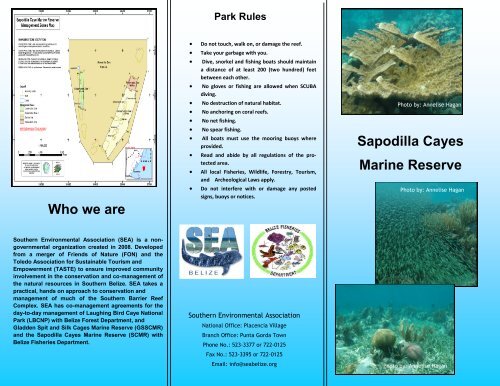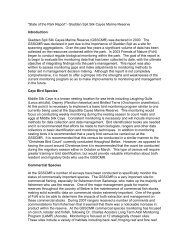Sapodilla Cayes Marine Reserve - Southern Environmental ...
Sapodilla Cayes Marine Reserve - Southern Environmental ...
Sapodilla Cayes Marine Reserve - Southern Environmental ...
Create successful ePaper yourself
Turn your PDF publications into a flip-book with our unique Google optimized e-Paper software.
Who we are<br />
<strong>Southern</strong> <strong>Environmental</strong> Association (SEA) is a nongovernmental<br />
organization created in 2008. Developed<br />
from a merger of Friends of Nature (FON) and the<br />
Toledo Association for Sustainable Tourism and<br />
Empowerment (TASTE) to ensure improved community<br />
involvement in the conservation and co-management of<br />
the natural resources in <strong>Southern</strong> Belize. SEA takes a<br />
practical, hands on approach to conservation and<br />
management of much of the <strong>Southern</strong> Barrier Reef<br />
Complex. SEA has co-management agreements for the<br />
day-to-day management of Laughing Bird Caye National<br />
Park (LBCNP) with Belize Forest Department, and<br />
Gladden Spit and Silk Cages <strong>Marine</strong> <strong>Reserve</strong> (GSSCMR)<br />
and the <strong>Sapodilla</strong> <strong>Cayes</strong> <strong>Marine</strong> <strong>Reserve</strong> (SCMR) with<br />
Belize Fisheries Department.<br />
Park Rules<br />
Do not touch, walk on, or damage the reef.<br />
Take your garbage with you.<br />
Dive, snorkel and fishing boats should maintain<br />
a distance of at least 200 (two hundred) feet<br />
between each other.<br />
No gloves or fishing are allowed when SCUBA<br />
diving.<br />
No destruction of natural habitat.<br />
No anchoring on coral reefs.<br />
No net fishing.<br />
No spear fishing.<br />
All boats must use the mooring buoys where<br />
provided.<br />
Read and abide by all regulations of the protected<br />
area.<br />
All local Fisheries, Wildlife, Forestry, Tourism,<br />
and Archeological Laws apply.<br />
Do not interfere with or damage any posted<br />
signs, buoys or notices.<br />
<strong>Southern</strong> <strong>Environmental</strong> Association<br />
National Office: Placencia Village<br />
Branch Office: Punta Gorda Town<br />
Phone No.: 523-3377 or 722-0125<br />
Fax No.: 523-3395 or 722-0125<br />
Email: info@seabelize.org<br />
Photo by: Annelise Hagan<br />
<strong>Sapodilla</strong> <strong>Cayes</strong><br />
<strong>Marine</strong> <strong>Reserve</strong><br />
Photo by: Annelise Hagan<br />
Photo by: Annelise Hagan
About the SCMR<br />
The <strong>Sapodilla</strong> <strong>Cayes</strong> <strong>Marine</strong> <strong>Reserve</strong> was declared in<br />
1996, that very same year it became a UNESCO World<br />
Heritage site. Due to it’s location in the Gulf of Honduras<br />
the SCMR has a long history. Mayan fishermen have<br />
left their legacy and signs of occupancy in the way of<br />
obsidian shards and broken pottery. Spanish fleets leaving<br />
the protection of Lake Izabal have carefully navigated<br />
around this section of the reef as powerful east<br />
winds could have easily created many shipwrecks.<br />
Strong currents however, have erased most evidence of<br />
these mariners’ activities. In recent years, the <strong>Sapodilla</strong><br />
<strong>Cayes</strong> have been a point of contention with both Guatemala<br />
and Honduras claiming sovereignty. Today the<br />
SCMR area continues to be used by Guatemalans, Hondurans<br />
and to a lesser extent Belizeans for swimming,<br />
snorkelling, diving and fishing.<br />
The reserve covers an approximate area of 125 km 2 and<br />
includes fourteen sand and mangrove cayes; namely,<br />
Tom Owens East and West, Northeast <strong>Sapodilla</strong> Caye,<br />
Frank's <strong>Cayes</strong> main, east and west, Nicholas Caye,<br />
Hunting Caye, Lime Caye, Ragged Caye, Seal <strong>Cayes</strong> I and<br />
II, and two unnamed sand cayes or ephemeral islands<br />
that lack vegetation. The cayes and the marine environment<br />
surrounding them are an important habitat for a<br />
wide variety of plants and animals.<br />
Photo by: Annelise Hagan<br />
Many of the species found in the SCMR including the<br />
Hawksbill Turtle and the Nassau Grouper are protected<br />
by law. Other important commercial species such as<br />
snapper, conch and lobster call the SCMR home. The<br />
protection of all of the species and different habitats<br />
within the <strong>Sapodilla</strong> <strong>Cayes</strong> is vital.<br />
Management<br />
SCMR was designated in 1996 but remained a paper park<br />
until 2001 when the on-site Belize Fisheries Department<br />
staff was hired. The Government of Belize recognized<br />
the many threats to the barrier reef system and its own<br />
lack of resources to combat these threats. This, along<br />
with a desire to involve stakeholders in the management<br />
process, prompted the Fisheries Department to sign a<br />
Memorandum of Understanding on February 1, 2001<br />
with the Toledo Association For Sustainable Tourism and<br />
Empowerment (TASTE) which has since merged with<br />
Friends of Nature to become SEA. Currently the reserve<br />
staff consists of a reserve manager, a biologist and 2<br />
rangers, who are based at their headquarters on Hunting<br />
Caye. The staff is responsible for day-to-day management,<br />
patrols, education and outreach. Like Gladden<br />
Spit and Silk Caye <strong>Marine</strong> <strong>Reserve</strong>, <strong>Southern</strong> <strong>Environmental</strong><br />
Association (SEA) now has a co-management<br />
agreement with the Fisheries Department.<br />
Photo by: Annelise Hagan<br />
SEA staff works closely with the reserve staff and conducts<br />
monitoring and research activities as well as education<br />
and outreach. Visitors are primarily from the surrounding<br />
countries such as Honduras and Guatemala. Every Easter<br />
and Christmas hundreds of these foreign tourists gather to<br />
camp, snorkel, sport fish and dive in beautiful waters. It<br />
has been somewhat of a tradition since the 1980s.<br />
Recreational Activities<br />
To many, the <strong>Sapodilla</strong> <strong>Cayes</strong> are some of the most<br />
beautiful islands in Belize. It is a very important<br />
tourist destination for many visitors from Guatemala<br />
and Honduras as well as Belize.<br />
Although visitation data is collected by the SCMR<br />
park rangers, it is also important to monitor recreational<br />
impacts in areas that are heavily used. This<br />
provides management with the opportunity to develop<br />
specific management measures to mitigate<br />
any negative impacts on these resources. Enjoying<br />
the white sand beaches and pristine waters of<br />
these beautiful islands is important to tourists as<br />
well as the staff and mangers of the <strong>Sapodilla</strong> <strong>Cayes</strong><br />
<strong>Marine</strong> <strong>Reserve</strong>.<br />
Photo by: Annelise Hagan<br />
Photo by: Annelise Hagan




